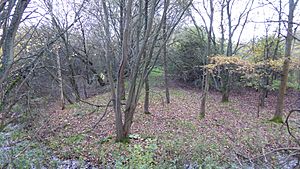Brimpton Pit facts for kids
| Site of Special Scientific Interest | |
 |
|
| Area of Search | Berkshire |
|---|---|
| Interest | Geological |
| Area | 1.6 hectares (4.0 acres) |
| Notification | 1984 |
| Location map | Magic Map |
Brimpton Pit is a special place in Berkshire, England. It covers about 1.6 hectares (that's like 4 football fields!). This site is known as a Site of Special Scientific Interest (SSSI) because it's super important for understanding Earth's history. It's also part of the Geological Conservation Review, which means it's one of the best places in Britain to study geology.
Scientists study Brimpton Pit because it used to be a gravel pit. This means people dug out gravel from the ground there. When they did, they found amazing clues about what the Earth was like many thousands of years ago!
Contents
What Makes Brimpton Pit Special?
Brimpton Pit is like a time capsule hidden in the ground. It holds secrets from a very long time ago.
Ancient Fossils and Pollen
Inside the layers of earth at Brimpton Pit, scientists found tiny fossils. These include:
- Molluscs: These are creatures like snails and clams that lived in water. Finding their fossils tells us about the ancient environment.
- Pollen: These are tiny grains from plants. Pollen can tell us what kinds of plants grew there in the past.
These fossils and pollen were laid down about 80,000 years ago. This was during a time when the Earth was much warmer than it had been before or after.
The Brimpton Interstadial
The warm period 80,000 years ago was first discovered and studied right here at Brimpton Pit! Because of this, scientists named this warm phase the Brimpton Interstadial. An "interstadial" is a short warm period during a longer ice age. It's like a mini-summer in the middle of a very long winter for the Earth. This specific warm period is also known as Marine Isotope Stage 5a.
Understanding the River Thames
Brimpton Pit also helps us learn about how the River Thames and its smaller rivers (called tributaries) have changed over thousands of years. By studying the layers of gravel and the fossils within them, geologists can piece together the story of how these rivers flowed and changed their paths long ago. It's like solving a giant puzzle about ancient landscapes!
Visiting Brimpton Pit
While Brimpton Pit is a very important scientific site, you can't see the amazing geology directly from the surface anymore. A footpath runs along the side of the site, so you can walk nearby. The western part of the site is now a field, and the eastern part is a dip in an area with trees and bushes. Even though the ancient layers are hidden, the discoveries made here have taught us so much about Earth's past!

